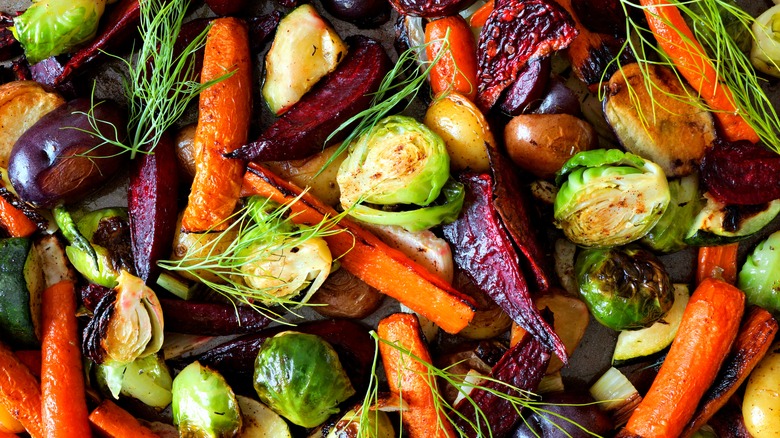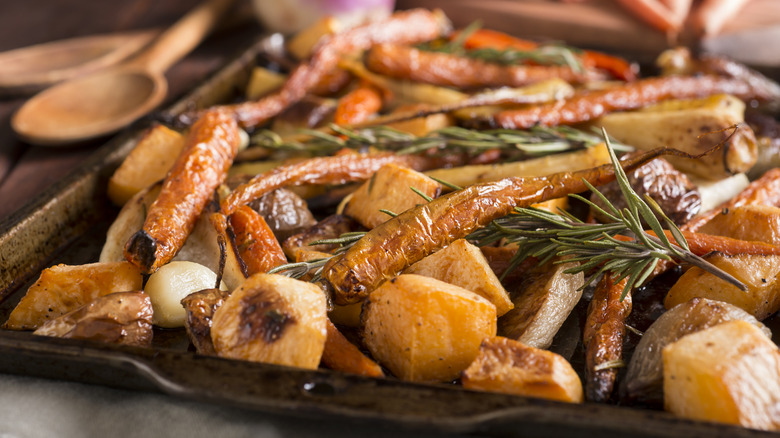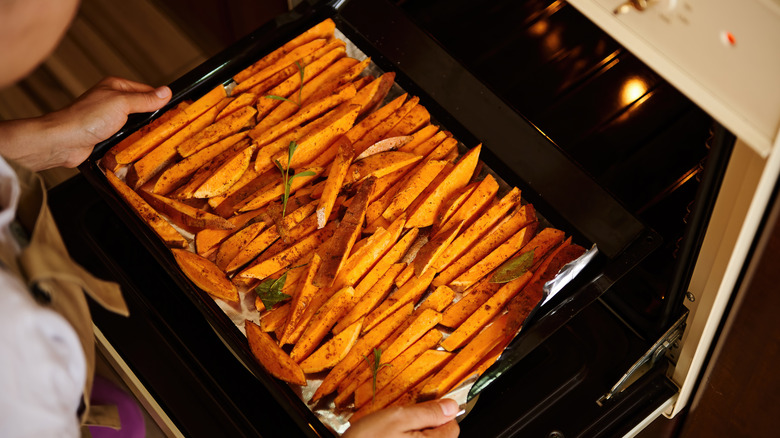Why Roasted Vegetables Taste Sweeter & How To Do It Right
Picture this scenario: You have a bunch of vegetables and are unsure about what to do with them. Beyond that, you lack the energy or brain space to make anything remotely complicated. What should you do? Roast them in your oven, air fryer, or convection oven to hit that sweet spot. Roasting makes it easy to achieve lightly browned, crispy-skinned vegetables with tender, honeyed interior flesh. Have you ever wondered why roasting makes vegetables taste sweeter? It's all about the caramelization process.
Raw vegetables can taste bitter, especially to people who may not be sold on eating them, such as kids or grown-up kids. Roasting vegetables mellows the flavor. Dry-heat cooking, either by roasting or frying, helps release the natural sugars in vegetables — but don't confuse caramelization with the Maillard reaction, which involves reducing sugars and amino acids. This caramelization is a non-enzymic browning reaction, which occurs as water evaporates and sugars break down from heat.
Likewise, different sugars caramelize at different temperatures. For example, sucrose and glucose caramelize at around 320 degrees Fahrenheit, and fructose caramelizes at 230 degrees Fahrenheit. In the last stage of caramelization, hundreds of new aromatic compounds form, creating a range of complex flavors. The result is a sweet, nutty, toasty flavor.
The best vegetables for roasting
Due to their sugar content, the best vegetables for caramelization are root vegetables, squash, and tubers (sunchokes, rutabagas, yams, etc.). Beets have the highest sugar content; other high-sugar-content vegetables include carrots, parsnips, and turnips. In the case of carrots, the cooking process involves both caramelization and the Maillard reaction because they also contain amino acids. As far as texture is concerned, don't try to soften your roasted vegetables the way you would with a tough cut of meat: Low and slow is your best bet because they need high heat to tenderize.
When your roasted root vegetables are ready to serve, you can use them in numerous preparations. They work seamlessly as a component in an entree or as an easy, tasty side dish that might even persuade the veggie haters in your life to try them out. Try sprinkling a mixture of roasted root vegetables with simple seasonings (salt and pepper will do) and herbs like rosemary and thyme. For extra sweetness, add a drizzle of balsamic vinegar. For a more substantial meal, serve them over rice or a bed of mixed greens with a protein like grilled chicken or steak.
Tips for roasting vegetables
Now that you know the benefits of roasting, we have some tips to help you get the best results every time. First, you want your oven to be preheated to 425 to 450 degrees Fahrenheit; roasting works best with high heat. Likewise, choose the proper vessel for the job. The ideal choice is a sheet pan since glass baking dishes aren't as good at conducting heat, and high sides can trap steam in the pan. For easier cleanup, line the tray with aluminum foil or parchment paper.
When roasting vegetables, size matters: Cut the vegetables into roughly 1-inch chunks. They should be uniform in size to help them cook evenly, although denser veggies like squash, potatoes, and root vegetables should be cut smaller than less-dense types (like broccoli or cauliflower). All veggies should be as dry as possible to avoid steaming. For the same reason, avoid crowding your pan with too many vegetables.
To achieve a perfectly crisp exterior, toss the veggies in a generous amount of olive oil before seasoning. Consider using spices like garlic powder, smoked paprika, dried herbs, Old Bay, or five-spice powder. However, avoid adding sugar too early, as it can burn the veggies. Also, they don't need it. When roasting, check on your veggies periodically to ensure they aren't burning, and turn them about halfway through the cooking time to caramelize all sides.


